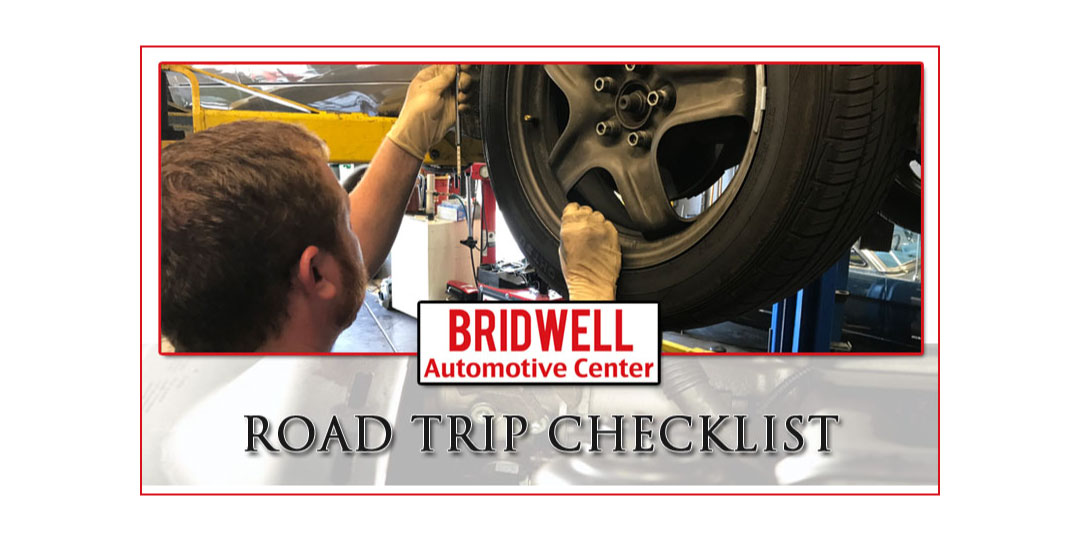If you are searching for “road trip checklist for car“, “is my car ready for a road trip“, “road trip inspection“, “car checklist before road trip“, “road trip high mileage car” or “how to prepare my car for a long road trip“, this road trip checklist should help!
Road Trip Inspection & Preparation Services
Get your car ready for your next road trip with our road trip inspection and preparation services.
Our road trip inspection and preparation services include:
- Inspecting battery, fuses & relays
- Inspecting tires and spare tire
- Inspecting belts and hoses for durability, leaks or cracks
- Inspecting brake fluid, engine oil, transmission fluid, power steering fluid etc
- We also finish the inspection by test driving the vehicle
The cost for the inspection is $79. Receive 15% off by showing us this coupon or by printing it out. Click here for Road Trip Inspection Discount. Good until 8/30/18. *Coupon can be used for road trip inspection only.[spacer height=”20px”]
Road Trip Checklist For Cars
Here’s a list of the items you should check on your vehicle before a road trip. Each of them are important to your safety and to make the trip trouble free and fun!
[one-half-first]
- Battery
- Engine Oil
- Transmission & Differential Fluids
- Hoses
- Belts
- Engine Coolant
- Window Washer Fluid
[/one-half-first]
[one-half]
[/one-half]
[spacer height=”20px”]
Battery Check
The battery isn’t something you always think about when getting ready for a road trip, but they can go out without much notice. In Arizona we all know that car batteries don’t typically last longer than about 3 years at the most. Also check the posts or terminals on top of the battery for signs of corrosion. The connection the wires make to the battery needs to be secure to the positive and negative leads on the battery. Use a wrench to ensure these connections are tight. Watch carefully for signs that you’re vehicle’s starting sluggishly, get it tested, and replace it if necessary.
Engine Oil Check
Road trips pack on the miles and most people don’t want to interrupt the fun to get an oil change while on the road. Get your oil changed before you set off on your road trip to keep your engine healthy. Your oil and it’s condition play a big role in how your vehicle’s engine wears and how many miles it will be good for. If the mileage on your trip is going to even get close to needing an oil change considering getting it done before you head off. It will help cut down on wear on your vehicle’s engine and avoid needing to get it done while on your vacation.
Transmission & Differential Fluid Check
Engine oil isn’t the only place lubricant is used to keep the parts of your vehicle moving properly as your transmission and differential also use it. Check your owner’s manual to find out when it’s due for your vehicle. These are typically a little harder to get to for your DIY oil changer and are best handled by a lube and oil shop. While they are down there consider having the U-joints a touch of grease to help your suspension operate smoothly.[spacer height=”10px”]
Hose Checks
The heat inside your engine bay causes rubber hoses to degrade faster than it would if it simply sat in a parts house. Because of the extreme heat your hoses should be check for being too hard and ready to crack. Look for any areas that attach to the radiator to the engine. Check near the connection points as the clamps tend to cause strain along with keeping an eye out for blisters and bulges in the hoses. Checking before you go helps you avoid that “side of the road” nightmare of steam pouring our of your engine and you calling for a tow truck instead of cruising the highway.
Belts
Belts in your vehicle transfer power from your engine to accessories like your alternator, water pump, ac compressor, power steering, and other critical systems. You should look for any signs of wear such as fibers cords showing, cracks, tears, if they are torn or ragged. Modern vehicles typically have a single belt called the serpentine belt. Most serpentine belts are good for up to about 50,000 miles. So if you’re under that, you should be just fine. You should check as many belts as your vehicle uses by pressing on them while the vehicle is off. If it moves more than half an inch the belt is probably stretched.
Engine Coolant
Engines run at about 212 degrees no matter what season it is. When it gets hot outside the engine coolant has to work harder to keep your vehicle’s engine cool enough. Make sure your engine coolant is in good condition before you set off on your trip. Modern vehicles are sent out from the factory with coolant that’s good up to between 100k and 150k miles. If you find that your coolant level is low do not mix water or the wrong type of coolant into your vehicle’s system. GM uses Dex-Cool (orange in color) while other vehicles typically use the green coolant that’s ethylene glycol-based. If the coolant is dirty or looks like it is rust colored you need to change it before you leave on your road trip.
Window Washer Fluid
Dust, dirt, insects, and rain are just a few of the reasons you might need to rinse your windshield while you’re cruising down the highway. Even mud or dirty water getting splashed up by other cars will make it impossible to see out of your car safely. Make sure your windshield washer fluid reservoir is full so you can spray as much as you need to while driving down the road. Most vehicles have the window water fluid reservoir marked with an icon that looks like your windshield and a line of spray. The reservoir will have a fill line so you’ll know if it is low or not.
Power Steering Fluid
Modern vehicles feature power steering that makes it easy to control your vehicle. If the fluid is low you’ll notice it gets harder to steer or you might notice a shrieking noise during turning. Many times this is caused simply by low power steering fluid. It is something that owners can choose to do but does require a number of steps such as warming up the car, finding power steering tank, and checking the fluid level. If you can find the power steering cap you should be able to check the level and add some where necessary. Ensure the tank cap is secured back in place if you do remove it.
Tire Pressure & Tread
Tires are the only part of your car that actually contacts the road, and is what keeps you safely on it. To find the right tire pressure for your vehicle’s tires look on the inside of the driver’s side door, on the fuel door, or in the glove box. Never just fill tires to the pressure listed on the tire as that number is generally the maximum pressure and not always exactly what your vehicle needs. Low tire pressure causes undue heat, tire wear, and wastes gas as there’s increased friction with the road. Before you set off know the pressure you need and check it with tire pressure gauge that you can buy at your local auto parts store.
Brake System
Most vehicles brake systems use what’s called DOT3 or DOT4 brake fluid which is known to attract and absorb moisture. When it gets water laden the color will change to a rust color and begin to damage your vehicle’s braking system. These repairs can be quite costly and frustrating for vehicle owners. If it’s been longer than about 3 years since you’ve had your brake system flushed and refilled with new fluid you should get it done before you leave. As the water level in the fluid rises the boiling point goes down and you can find yourself with less effective braking. It’s better to find the rust colored brake fluid than find out as your coming down a steep canyon and have ineffective brakes.
Air Filters
Your vehicle is likely equipped with 2 air filters. One for the engine and one is called the cabin air filter. If there’s too much dirt, dust, or debris in your air filter your vehicle has to work much harder to run and keep you cool. Take the strain off your ac compressor and motor by changing your air filters if they look dirty. The engine air filter is located under your hood and cabin air filters vary, check your owner’s manual for more information one where to find it and which filter you need to replace them with.
Spare Tire
First off you should check to make sure your vehicle is equipped with one. Some models of newer vehicle’s include an inflator where the spare tire should be and older vehicles might have had their’s used and not put back. Make sure your spare is where it should be and ready for use if you need it. You should check the tire pressure to make sure it’s up the the job and fill it when necessary. Checking before you go means you’ll be safer on the road in case you run over a nail in the heart of Death Valley.
Road Test
Before you start your road trip prep and after you’ve performed it make sure you take your vehicle on a test drive on the road. This will help you listen for unusual shaking, noises, and signs of trouble in your vehicle’s gauges. Pay attention to how the car behaves and sounds during the road test. If you feel it pulling, vibrating, or hear unusual moaning or grinding from the wheels. Grinding noises are a sign of bad hub bearings while a car that pulls one way or another means bad alignment. If your car squeals or shimmies under braking your pads or rotors may be worn or warped. Pay close attention to catch problems now so you don’t ruin your fun later!
Road Trip Checklist for High Mileage Cars
Higher mileage cars have a higher risk of having a problem. Depending on how high your mileage is and weather you get regularly scheduled maintenance done at regular intervals will determine what you parts of your car your should inspect and what other issues could come about.
- Check all items in the car checklist above, plus
- Check Thermostat & Water Pump
- Check Alternator
- Check Radiator
- Check Rotors
- Spark Plugs & Wires
- Cabin Air Filter
- Freon Check
Car Maintenance After A Long Road Trip
It is also wise to get your car inspected and maintenance after a road trip to ensure that your fluids are still filled properly, tires are still within normal wear etc and that there are no new issues since the long trip.
Live In The Scottsdale Area? Get Your Inspection Done At Bridwell Automotive Center!
Get your road trip inspection and preparation service done at Bridwell Automotive Center, located at 7171 E Lincoln Dr. Scottsdale, Arizona 85253 or call (480) 948-4781 for more information.







